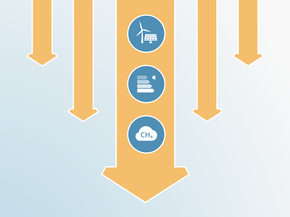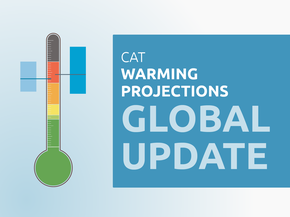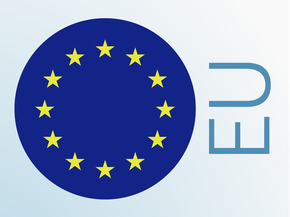Country action
National policies
To keep the Paris Agreement 1.5˚C temperature goal within reach, it is imperative that global CO2 emissions reach net zero around 2050. The Paris Agreement requires countries to peak global emissions as soon as possible and to achieve a balance between GHG emission sources and sinks of removals in the second half of this century (Article 4(1)). Further, the Paris Agreement requires developed countries to set economy-wide emissions reduction targets and developing nations to work towards those (Article 4(4)) (UNFCCC, 2015). The Agreement does not explicitly exclude emissions from international aviation, nor does it provide a role for ICAO to address these emissions (Dehon, 2021). Therefore, the CAT understands that national governments must include international aviation in their NDC targets.
At the ICAO’s 41st Assembly in 2022, member states agreed to a long-term aspirational goal (LTAG) for net zero CO2 emissions from international aviation by 2050 (ICAO Assembly, 2022). The Assembly Resolution, which tasks the ICAO Council with coordinating the LTAG implementation, urges states to contribute to this goal and to submit voluntary action plans (ICAO Assembly, 2022; Mithal and Rutherford, 2023). As of May 2025, 150 out of 193 member states have submitted voluntary action plans (ICAO, 2025b).
Just four jurisdictions are responsible for a quarter of international aviation emissions. These are the EU27 (10.4% in 2019), the United States (7.9% in 2019), China (4.4% in 2019) and the United Kingdom (3.9% in 2019) (Graver et al., 2020). Japan, the United Arab Emirates, and India are other important players: each was responsible for 2–3% of global CO2 emissions from international aviation in 2019. Within the European Union, Germany, France, and Spain have the highest emissions from international aviation (Graver et al., 2020).
While some countries have started addressing emissions from international aviation, definitions for “international aviation”’ vary widely between governments. The United Kingdom, for instance, covers emissions from all outgoing flights in its sixth carbon budget, but does not include emissions from incoming flights (UK Climate Change Committee, 2020). The Biden Administration’s US net zero GHG aviation goal did not cover all outgoing and/or incoming flights but rather covered emissions from flights operated by US airlines between two countries. For instance, if Delta flies between London and Paris, the emissions from that flight were covered, but if British Airways flies from New York to London, the emissions from that flight were not included in the now-abandoned US goal.
European Union
The EU and its 27 member states include international aviation in their NDC for 2030 (Germany and the European Commission, 2020). The Union’s climate neutrality target, however, does not explicitly cover emissions from international aviation.
Despite efforts from the European Commission and the European Parliament to reform the EU Emission Trading Scheme (ETS) and introduce a tax on kerosene and quota for SAF, the EU's measures to reduce emissions from international aviation remain insufficient: the ETS’s coverage remains too limited, the current SAF quota is too low, and the push for a kerosene tax has stalled (Hencz, 2025).
EU ETS Directive
The EU ETS is limited in scope, covering only flights in the European Economic Area (EEA), i.e. 27 EU member states, Norway, Liechtenstein, and Iceland. Flights from the EEA to Switzerland and the United Kingdom fall under the EU ETS, while flights from these two countries to the EEA are covered by the Swiss and UK ETS, respectively.
The EU ETS originally covered all international flights to and from the EEA. However, to allow the continuation of developing a global approach to limiting emissions from international aviation through ICAO, the EU “stopped the clock” in April 2013, limiting the coverage of its ETS to flights taking off and landing within the EEA (European Parliament and Council, 2013).
The EU ETS was revised in 2021 and 2022. During the last revision, the EU ETS was expanded to cover flights between the EEA and the EU’s outermost regions (e.g. Guadeloupe, Canary Islands, Madeira), unless these flights connect to the Member State to which the outermost region belongs (European Commission and European Parliament, 2023a). This means that a flight from Tenerife to Madrid is not covered by the EU ETS, but a flight from Tenerife to Paris is.
While the European Parliament pushed for expanding the scope to include all international flights departing from the EU, the suspension on including flights outside the EEA will remain in place until at least 2026 (European Commission and European Parliament, 2023a). At that time, the Commission will prepare a report assessing the environmental integrity of CORSIA. In addition, the Commission will develop a legislative proposal to expand the EU ETS scope if the ICAO Assembly does not strengthen CORSIA in line with the long-term global aspirational goal by the end of 2025, or if CORSIA continues to cover less than 70% of international aviation emissions.
The decision not to extend the scope of the EU ETS to all flights departing from EEA countries is a missed opportunity. As discussed in the section on CORSIA, the offsetting scheme suffers from several limitations and is unlikely to deliver real emissions reductions. An assessment commissioned by the European Commission in 2020 found that the EU ETS, if extended to all international flights leaving the EEA, would deliver greater emissions reductions than CORSIA (ICF Consulting et al., 2020).
The recent EU ETS reforms resulted in a gradual phase-out of free allowances for airlines, although so-called sustainable aviation (SAF) allowances will be allocated for free until 2030 (European Commission and European Parliament, 2023a). In 2024, 25% of all allowances will be auctioned, in 2025 50%, and from 2026 onwards 100%. This could provide airlines with a stronger economic incentive to reduce emissions on inter-EEA flights. While free allowances are phased out, the EU will distribute 20 million free SAF allowances between 2024 and 2030 (European Parliament and Council, 2025). These are meant to bridge the price gap between SAF and standard jet fuel. Only airlines that invest in SAF are eligible to receive SAF allowances.
MRV of non-CO2 GHG forcers from aviation
The revised EU ETS Directive introduces a requirement for aircraft operators to report on the non-CO2 effects from aviation, starting in 2025 (European Commission and European Parliament, 2023a). Implementation of the non-CO2 monitoring, reporting and verification (MRV) can help to increase understanding of aviation’s non-CO2 climate impacts, which are estimated to contribute to two-thirds of aviation’s radiative forcing (Lee et al., 2021), and mitigation measures to address them.
The EU ETS agreement adopted in 2022 specified that the non-CO2 MRV requirement would apply to all flights arriving at and departing from the EEA. However, the Commission later decided that only flights within the EEA and to the United Kingdom and Switzerland would be covered in the first two years (T&E, 2024). This means that only a third of Europe’s non-CO2 aviation impact falls within the MRV framework’s scope.
Based on a review of the MRV results, which is to be published by the end of 2027, the European Commission may develop a legislative proposal to expand the scope of the EU ETS to cover the non-CO2 forcers from aviation (European Commission and European Parliament, 2023a).
Kerosene tax
As part of the ongoing proposal to revise the Energy Taxation Directive, the Commission proposed implementing a tax on kerosene used on intra-EU private and commercial flights (European Commission, 2021). Such a tax would be gradually implemented to reach a minimum rate of 10.75 EUR/GJ in 2033. The Commission’s proposal has not been adopted as of September 2025.
Quota for the use of SAF
The EU defines SAF to include biofuels, advanced biofuels, and synthetic fuels. The ReFuelEU Directive requires fuel suppliers to supply minimum shares of SAF at EU airports, starting at 2% in 2025, rising to 6% in 2030, and 70% in 2050 (European Commission and European Parliament, 2023b). Synthetic fuels must account for at least 1.2% of SAF in 2030 and 35% of SAF in 2050.
The SAF quota is an important policy lever. The ReFuelEU Directive sends a clear support signal to SAF producers and can help to spur demand and supply of sustainable aviation fuels. However, the current quota is too low to ensure bankability of early-stage, advanced SAF projects (Navarrete et al., 2025).However, the quota falls short of the level that global benchmarks show is necessary for the aviation sector to be aligned with a 1.5°C trajectory. By 2030, SAF should account for 10–15% of global aviation fuel supply, rising to 100% by 2050 (UNFCCC, 2021; Boehm et al., 2023; IEA, 2023). Governments in the Global North should aim for an even more ambitious SAF uptake. Raising ambition in the EU and other wealthy, high-emitting countries allows for more moderate uptake in countries in the Global South.
Although the SAF quota will help scale the use of SAF, the increased production of biofuels is concerning. Biofuel production has a range of potential negative sustainability implications, including deforestation, biodiversity loss and food insecurity (Kline et al., 2015; Hof et al., 2018; Calvin et al., 2020; Ahmed et al., 2021; Clarke et al., 2022; Hanssen et al., 2022). It also directly competes for land dedicated for biological carbon dioxide removals (Becken et al., 2023), making it more difficult to neutralise economy-wide residual emissions. For a more detailed discussion on biofuel and synthetic SAF, see the section on Mitigation options.
The United Kingdom
The new UK government, which came into leadership following the UK’s general election in July 2024, does not plan to significantly deviate from the previous government’s course on addressing emissions from international aviation (Department for Energy Security and Net Zero, 2024). The UK government’s independent advisory board on climate change, the UK Climate Change Committee (CCC), forecasts that aviation will be largest source of emissions across all sectors by 2040, accounting for 27% of the UK’s total emissions (UK Climate Change Committee, 2025).
The previous UK government announced in 2021 its intention to include emissions from international aviation and shipping in its sixth carbon budget for the period 2033–2037 (BEIS, 2021). However, as of September 2025, the inclusion of these sectors and their emissions had not yet been legislated, though the government policy is acting on the basis that it will be legislated subject to parliamentary scheduling. Emissions from international aviation cover outgoing flights only (UK Climate Change Committee, 2020). While the 2019 Climate Change Act does not specifically mention emissions from international bunkers, the UK government stated that these emissions are included in the net zero target for 2050, which was set on an economy-wide basis (BEIS, 2021).
In July 2022, the previous UK government presented its Jet Zero strategy, which is to bring the UK aviation sector to “net zero” by 2050. The new government plans to retain the strategy. It is important to note that, in this context, “net zero” does not mean reducing emissions and eliminating the negative climate impacts of aviation by 2050, but rather enabling an increase in emissions that is to be offset through the UK ETS, CORSIA, and other offsetting mechanisms outside the aviation sector. Although non-CO2 emissions and impacts contribute to two-thirds of radiative forcing (Lee et al., 2021), the Jet Zero strategy does not set clear targets for their elimination. The new UK government has not implemented any further regulation to mitigate non-CO2 impacts from international aviation but has established a research and development program for academia and industry to develop mitigation options for aviation’s non-CO2 impacts (Tyers et al., 2025).
No demand reduction measures
The previous UK government argued that the UK can achieve “Jet Zero” without government interventions to limit growth in aviation demand (UK Department for Transport, 2022). Instead, the Jet Zero strategy envisages that demand can grow by 70% between 2021 and 2050. The new government appears to be aligned with its predecessor and has not introduced any demand reduction measures. Allowing for continued growth in aviation demand runs directly counter to the advice of the UK’s CCC, which stated that passenger growth should be limited to a maximum of 25% above 2018 levels by 2050 and that no net expansion in airport capacity should be permitted (CCC, 2020).
The new government confirmed that it is not opposed to expanding airport capacity “where it provides economic growth,” which it considers consistent with the government’s “legally binding net zero target and strict environmental standards” (Burford, 2024; Department for Energy Security and Net Zero, 2024). Given the CCC’s advice that no new airport expansion should occur without a UK-wide capacity management framework, the UK government should be unequivocal in opposing airport expansion, and instead develop strategies to manage and reduce demand for aviation.
UK ETS and CORSIA
The previous UK government expected that the UK ETS and CORSIA, together, could reduce emissions of flights departing the UK by around 25% by 2050 (UK Department for Transport, 2022). This seems an optimistic estimate, given CORSIA and the UK ETS constraints. As explained in the section on CORSIA, the scheme is highly unlikely to drive any significant CO2 reductions from aviation. The UK ETS only covers domestic flights and flights to the EEA, which are only responsible for less than a quarter of emissions from flights departing from UK airports. Most emissions (83%) are generated by flights to countries outside Europe (UK Department for Transport, 2022; Finch, 2024; Krajinska and Vitry, 2025). The new UK government does not plan to review or revise the coverage of the UK ETS .
In December 2024, the new UK government launched public consultation on the implementation of CORSIA and its interaction with the UK ETS (UK Department for Transport, 2025). The consultation period ended in February 2025, but, as of September 2025, the government has not yet published its response.
GHG removals
The UK government further plans to offset emissions through Greenhouse Gas Removals, including Direct Air Capture, a technology that is not yet mature, and has a highly uncertain abatement potential (Fuss et al., 2018; Jeffery et al., 2020).
There is limited global potential for capturing CO2 from the atmosphere and permanently storing it (Fuss et al., 2018; Jeffery et al., 2020). This limited potential should be reserved to balance out residual emissions to achieve net zero global emissions, rather than to facilitate a stark increase in aviation sector emissions in one of the world’s wealthiest countries.
SAF mandate
The new UK government expects SAF to play an important role and commits to have UK jet fuel demand be met by 2% SAF in 2025, 10% in 2030 and 22% in 2040 (UK Department for Transport, 2024). There will also be a revenue certainty mechanism to provide confidence to investors seeking to build SAF plants to meet UK demand.
The level of SAF rollout envisaged by the UK government is at the lower end of what global benchmarks show is necessary for the aviation sector to be aligned with a 1.5°C trajectory. By 2030, SAF should account for 10–15% of global aviation fuel supply (UNFCCC, 2021; Boehm et al., 2023; IEA, 2023). Governments in the Global North should aim for an even more ambitious SAF uptake. Raising ambition in the UK and other wealthy, high-emitting countries allows for more moderate uptake in countries in the Global South.
While 10% is at the lower end of global benchmarks, it will be challenging for the UK achieve this level of SAF without exacerbating sustainability issues. The UK government also allows for synthetic SAF and requires that by 2040, 3.5% of all jet fuel in the UK comes from low-carbon electricity (UK Department for Transport, 2024). However, especially on the shorter term, most SAF will be biofuels.
The UK government’s sustainability criteria for SAF allow biofuels made from used cooking oil, forestry residues, and recycled plastics. Given the limited availability of these bio-resources, it is questionable whether the UK can reach its 10% SAF goal by 2030, without exacerbating other sustainability issues (see also the section on Mitigation options). The absence of demand measures only compounds these issues.
The United States
The US government, under the Trump Administration, is no longer committed to achieving economy-wide net-zero emissions by 2050 – a target which the Biden Administration set in 2021. The Biden Administration also sought to reach net-zero emissions from the US aviation sector by 2050 (FAA, 2021). The Biden Administration’s goal covered CO2, N2O, and CH4 emissions, but did not consider other climate impacts from aviation such as cirrus trails. Although the Trump Administration has not explicitly revoked the aviation-specific net-zero target, the administration’s policies and actions—notably, its rejection of the International Maritime Organization’s (IMO) net-zero framework for international shipping—indicate that the target has been dropped (U.S. Department of State, 2025).
Under the Trump Administration, the US Department of Energy (DOE) has removed websites for Biden-era SAF programmes and shifted its language around SAFs (Alvey, 2025). Instead of using the term “sustainable aviation fuel,” the DOE now uses “synthetic aviation fuel,” signalling its broader de-prioritisation of decarbonisation efforts.
Even under the Biden Administration, the US government used a limited definition of international aviation, which leaves out a substantial share of emissions from international flights departing from US airports. The government defines the ‘US aviation sector’ as:
- Domestic aviation (i.e. flights departing and arriving in the US and its overseas territories);
- Flights operated by US airlines between two countries (e.g. a flight from London to Paris by Delta would be covered, but a flight from the US to the UK operated by British Airways would not); and
- Emissions from US airports, for instance from ground operations.
Under the Biden Administration, the US government proposed measures to reduce emissions from aviation, but with a strong focus on domestic flights. In the SAF Grand Challenge Roadmap, the US government established the goal for SAFs to account for 100% of domestic aviation fuel demand by 2050. To enable the target’s realisation, the US government aims to scale the production and use of SAF to 11 billion litres per year by 2030 and over 130 billion litres per year by 2050 (U.S. Department of Energy, 2022a). In 2022, SAF production only reached 60 million litres (U.S. Environmental Protection Agency, 2024). The Trump Administration has not explicitly revoked this set of SAF production and consumption targets.
The Inflation Reduction Act (IRA) of 2022 introduced two tax provisions to spur the development and adoption of sustainable fuel technologies by the aviation industry: (The White House, 2023). the Clean Fuel Production Credit and the Sustainable Aviation Fuel Credit. The IRA also allocated nearly USD 300m in grants to develop and deploy projects related to sustainable aviation fuel and low-emission aviation technologies (The White House, 2023).
The Clean Fuel Production Credit incentivises the production of clean transport fuels, including SAFs. The One Big Beautiful Bill Act (OBBB) of 2025 modifies the credit. The OBBB extends the credit from 2027 until 2029. However, the Act also reduces the maximum tax credit value from USD 1.75 per gallon to USD 1.00 per gallon, establishes requirements for domestic production, and excludes indirect land use change emissions when calculating fuel lifecycle emissions. The exclusion of indirect land use change emissions—a critical measure for understanding the unintended emissions impact of biofuel production—significantly undermines the credibility of the lifecycle emissions analysis.
The Sustainable Aviation Fuel Credit, which phased out at the end of 2024, incentivised the sale or use of SAFs that reduce lifecycle GHG emissions by at least 50% compared to petroleum-based jet fuel are eligible for a tax credit of USD 0.33 per litre. This credit was progressive; it increased for each percent that the emissions reduction exceeds 50% (U.S. Department of Energy, 2022b).
Although the US participates in CORSIA, and the first phase of this scheme started in 2024, the US government did not implement CORSIA into national law under the Biden Administration (Gualandi, 2024).
China
China’s 14th Five-Year Plan includes several targets for decarbonising airline and airport operations. Notable is the target to reduce CO2 emissions per tonne-kilometre by 4.5% in 2025 relative to 2020 levels; although the target does not clearly distinguish between domestic and international flights (Yin and Zhou, 2022). In August 2025, the Chinese government announced the expansion of the national ETS to include the aviation sector, pending sector readiness and data quality assessments, but without a clear timeline (Howe, 2025). The implications for emissions from international aviation therefore remain uncertain.
Sectoral initiatives
In the UK, the aviation industry committed to net zero CO2 emissions by 2050, in line with the UK Government targets (Sustainable Aviation, 2019). The industry, like the UK government, does not see any need for demand measures.
According to the UK industry’s Decarbonisation Roadmap (Sustainable Aviation, 2019), the UK could accommodate an increase in passenger numbers of 70% in the next three decades, but acknowledges that new technologies, operational improvements, and SAF would not be able to keep up with this increase in demand. Rather, the EU ETS, CORSIA, and carbon removal measures would be key in bringing British aviation emissions to net zero.
The UK industry commits to make use of natural and technology-based carbon removals, but neither of these are solutions to depend on. Non-durable, land-based carbon removals, such as sequestration in forests, bring a high risk of impermanence: the sequestered carbon will be released back into the atmosphere within years to centuries, negating any benefits of sequestration in the first place. The potential for land-based carbon removals is limited and needed to balance out residual global emissions; it is questionable as to whether this solution should be used to “neutralise” a stark increase in emissions growth in the world’s wealthiest nations.
The European aviation industry has drafted a pathway to net zero CO2 emissions from aviation by 2050 (NLR - Royal Netherlands Aerospace Centre and SEO Amsterdam Economics, 2021). The pathway is ambitious but fails to describe the industry’s role in financing, or otherwise enabling, the net-zero transition.
The European aviation industry’s pathway foresees a major role for sustainable aviation fuels and hydrogen: by 2050, these two technologies, including their impact on demand, would reduce BAU emissions by 67% (NLR - Royal Netherlands Aerospace Centre and SEO Amsterdam Economics, 2021). Improved kerosene technologies, air traffic management and operations would account for the reduction of another 23%, while economic measures would contribute to a reduction of 10% below BAU.
The European aviation industry calls for government incentives, including subsidies, to scale up the use of SAF. At the same time, Airlines 4 Europe (A4E), one of the main groups behind the net zero pathway, argues against a kerosene tax (A4E, 2023). A4E claims such a tax “would be a setback for the decarbonisation efforts of the European aviation industry and jeopardise our global competitiveness.”
The aviation industry’s expectation that public resources will be used to scale up SAF and implement other decarbonisation measures, without the industry itself financially contributing, is troublesome. A kerosene tax could raise funds for SAF development. It could also help decrease emissions from short- and medium-distance flights, as lower-carbon modes of transport would become economically more attractive if a tax were implemented.
In February 2022, European countries and aviation industry groups signed the Toulouse Declaration, reaffirming their commitment to net zero carbon from international aviation by 2050 (ACI Europe, 2022).
Further analysis
Latest publications
Stay informed
Subscribe to our newsletter





